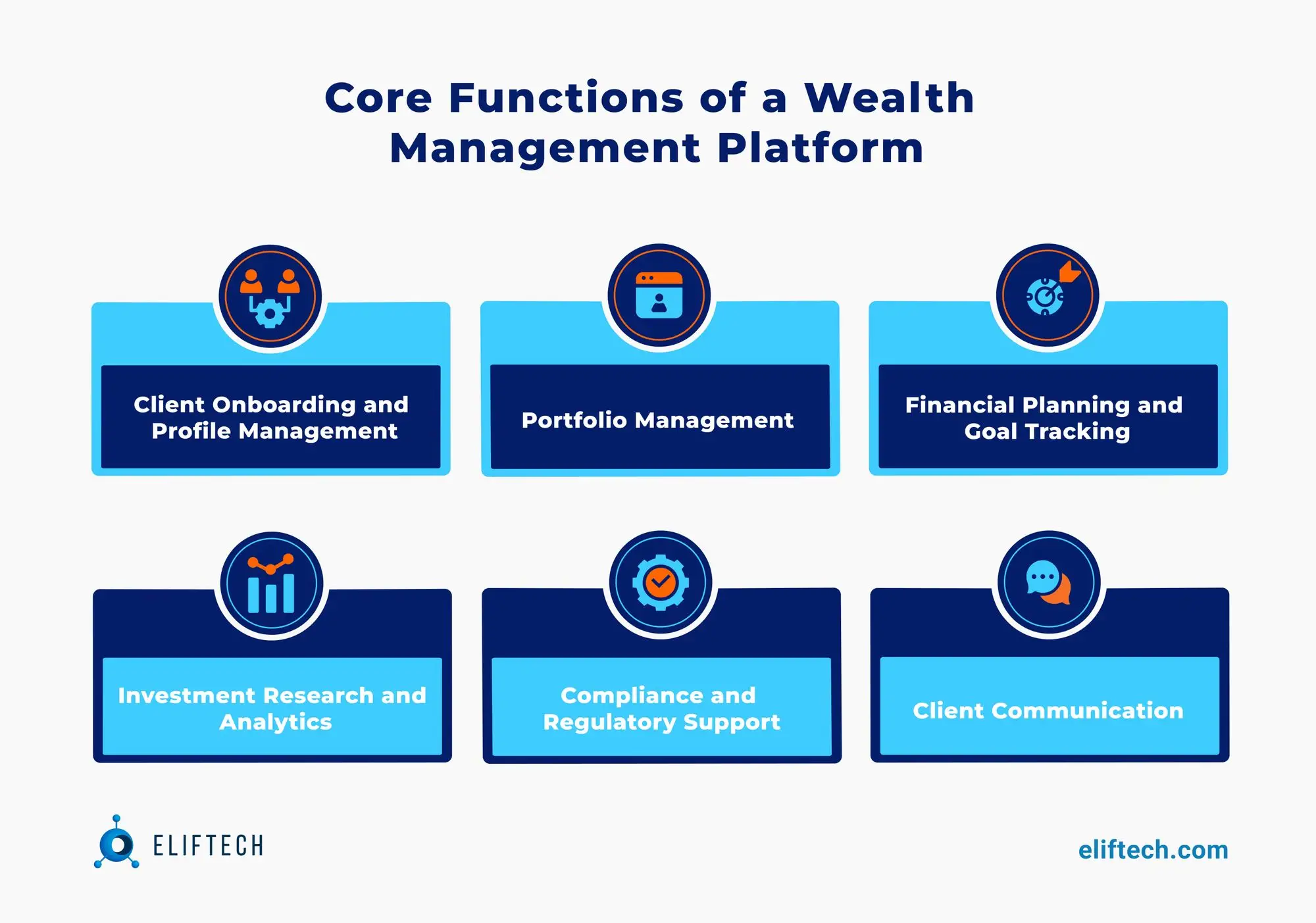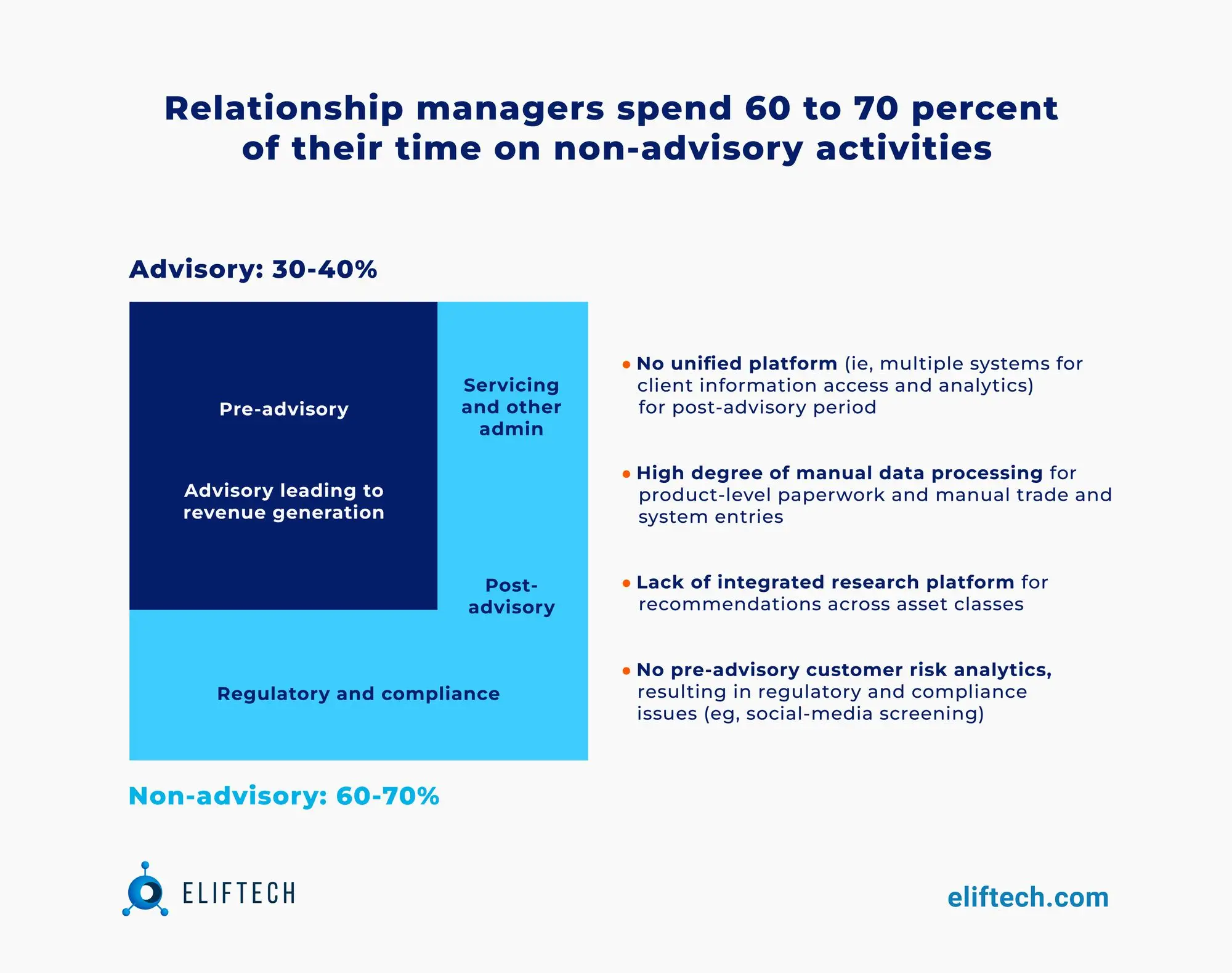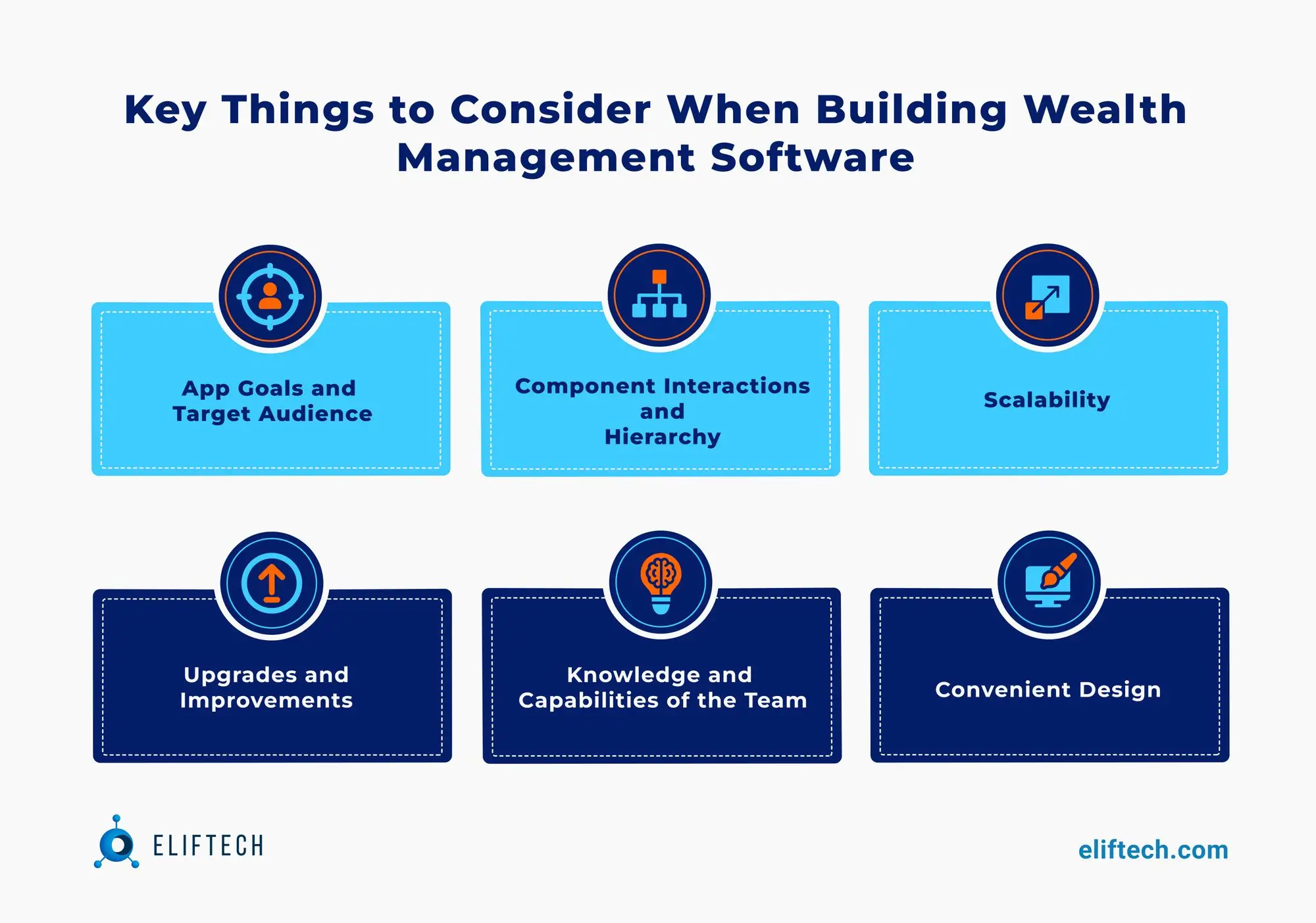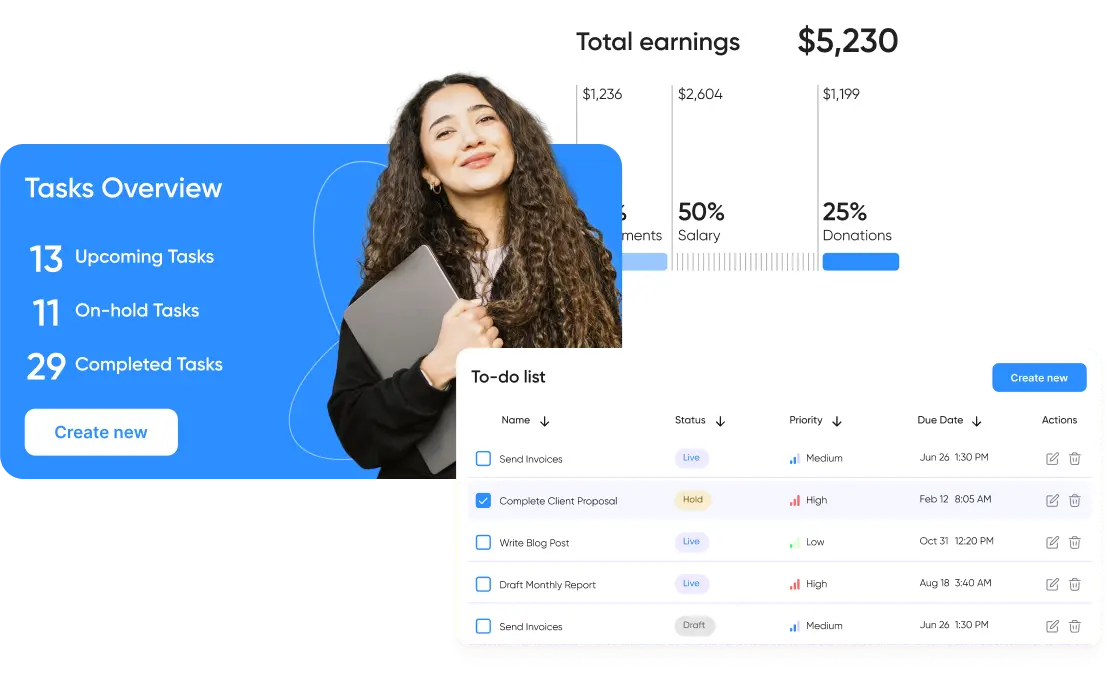Wealth Management
Developing Wealth Management Platform From Scratch: Challenges, Process, and Tips
Are you ready to seize the opportunities in the booming wealth management industry? With the projected market size for wealth management platforms set to reach $8.99 billion USD by 2028, businesses must seize this chance to develop their own tailored solutions and gain a competitive edge. However, building a successful wealth management platform from scratch is a complex task that demands expertise, resources, and time. As a seasoned software development provider with a proven track record in fintech, we will guide you through the process, tackle the challenges, and share valuable tips for creating a thriving platform from scratch.
Core Functions of a Wealth Management Platform
In order to begin the development process, it's crucial to have a comprehensive understanding of the essential functions and components that make up an effective wealth management platform. This knowledge can help you prioritize features, tailor your product to your customers' needs, and ensure you're providing a comprehensive range of services. In this section, we'll break down the key features of a wealth management platform and provide insight into how each function contributes to the platform's success.

Client Onboarding and Profile Management
Both client onboarding and profile management are vital components of a comprehensive digital wealth management platform. They allow the platform to gather crucial client information, enabling personalized investment recommendations. In addition, the platform should prioritize a seamless onboarding process. This user-centric approach fosters customer satisfaction and promotes long-term retention.
Portfolio Management
Another vital component of a wealth management platform is portfolio management. It includes diverse functionalities, such as asset allocation, risk management, rebalancing, and investment performance analysis. With the assistance of these features, advisors can make informed and strategic investment decisions, ultimately helping clients to increase their returns and meet their financial objectives.
Financial Planning and Goal Tracking
Financial advisors leverage the analysis of clients' expenses, debts, and incomes to provide customized suggestions that enhance their overall financial well-being. Therefore, assessing clients' financial health and creating personalized financial plans that consider both immediate and long-term objectives are crucial aspects of the platform's functionality. To support these objectives, a comprehensive platform should offer tools for tracking goals, generating retirement projections, performing scenario analysis, and simulating investment strategies.
Investment Research and Analytics
A digital wealth management platform with a reliable investment research and analytics feature allows advisors to conduct in-depth research and analysis to make informed and strategic investment decisions for their clients. This feature provides market outlooks, economic updates, and risk management functionalities that help advisors identify investment opportunities and minimize risks.
Compliance and Regulatory Support
Compliance and regulatory support play a crucial role in ensuring that advisors adhere to regulatory requirements and industry standards. To empower advisors in this regard, wealth management platforms go beyond basic functionalities by integrating advanced tools. The latter include identity verification, risk assessments, and document management, which streamline compliance processes and mitigate the risk of regulatory violations.
Client Communication
To facilitate effective communication, platforms often incorporate interactive client portals and secure messaging systems. These features provide a convenient and secure channel for clients to interact with their advisors, ask questions, seek clarifications, and receive updates on their financial progress.
Essential Tools and Technologies in a Wealth Management Platform
Efficiency is key in wealth management. To optimize processes and gain a competitive edge, businesses can leverage a range of tools and technologies, including cutting-edge innovations like advanced analytics, artificial intelligence, automation, as well as established solutions such as customer relationship management (CRM) systems. These tools improve performance and add value to clients. Let's explore the areas in wealth management that can benefit from these technologies and how they can bridge the various gaps.
Customer Relationship Management (CRM) Systems
The role of CRM systems has become increasingly essential in addressing gaps within the wealth management industry. One primary example is the mitigation of compliance issues through the maintenance of accurate records and the provision of automated reporting. CRM systems that are customized according to the specific needs of a wealth management platform can facilitate client communication, task tracking, client profiling as well as identify trends and patterns, which can provide valuable insights.
Financial Planning Tools
Financial planning tools are an essential component of any wealth management platform because they provide numerous benefits for both clients and advisors. They provide a better way to identify potential areas of risk in clients' portfolios, which allows for proactive adjustments and improved risk management. They also help clients simulate different scenarios, which is an effective way to build resilience in the face of unforeseen circumstances.
Portfolio Management Tools
The integration of portfolio management into wealth management platforms helps bridge gaps and deficiencies in the industry. For example, these tools automate technical tasks like rebalancing and record-keeping, which frees up valuable time for advisors to focus on complex client needs. Furthermore, portfolio management tools provide advisors with in-depth insights into the client's overall investment portfolio. With the integration of advanced analytics and machine learning, advisors can identify potential areas of risk proactively.
Risk Management Solutions
Integrating advanced analytics and machine learning enables advisors to proactively identify potential areas of risk, revolutionizing the way risks are managed in the wealth management industry. They give more opportunities for managers to run stress testing, evaluate portfolios for risk exposures, and eventually facilitate risk-adjusted decision-making.
Solid Cybersecurity Architecture
A solid cybersecurity architecture of a management platform is essential for preventing industry-related gaps and emerging cyber threats. As companies increasingly embrace emerging technologies like cloud computing, IoT, and AI, they leave themselves open to new vulnerabilities and security challenges. A sound cybersecurity architecture can cover these gaps and provide proactive security measures that are adaptable to emerging security trends.
Robo-Advisors
The McKinsey survey conducted among relationship managers revealed that, on average, they allocate 60 to 70% of their time to non-revenue-generating activities. Hence, time spent by personnel costs businesses money but does not drive revenue. The introduction of robo-advisory is a way to cut expenses without sacrificing the client’s comfort.

Data Analytics and AI
Data analytics and AI are essential in a wealth management platform as they address industry gaps. They provide personalized recommendations, enhance risk management, detect fraud, offer market insights, and improve operational efficiency. These technologies optimize decision-making and deliver superior client experiences, making them crucial components of a modern management platform
Integration With Third-Party Services
In order to create a comprehensive and efficient wealth management platform, it is crucial to seamlessly integrate various entities such as banking systems, custodians, market data providers, and other financial tools. These integrations play a pivotal role in enabling the smooth flow of information from different systems.
Mobile Accessibility
Recent statistics indicate that a significant majority of clients, specifically 6 out of 10, prefer accessing and managing their investments through mobile apps rather than using the web version. This shift in client behavior highlights the growing importance of mobile app platforms in the wealth management industry.
The convenience and flexibility offered by mobile apps make them a significant driving force in user preferences. For example, mobile wealth management allows clients to easily access their investment portfolios, track performance, and make transactions on-the-go, anytime and anywhere.
Building an Architecture of Wealth Management Platform
A well-designed architecture ensures the platform's scalability, reliability, and performance, making it a key factor in the proper functioning of a wealth management platform. It governs the technical infrastructure, software, and design principles that underlie the platform's effective operation. Let’s explore the critical elements of a robust wealth management platform's architecture.
Technology Stack
A robust technology stack is crucial for the successful functioning of a wealth management platform. Here's an overview of the major components of the tech stack:
Backend Development: This involves using server-side programming languages such as Java, Python, or .NET, along with frameworks like Spring, Django, or ASP.NET. These tools enable the development of a strong backend logic and APIs, ensuring seamless data processing and functionality.
Database Management: Relational databases like MySQL or PostgreSQL, as well as NoSQL databases like MongoDB or Cassandra, are utilized to store and manage client data, investment information, and transaction records. These databases ensure efficient data organization and retrieval.
Front-end Development: Web technologies like HTML, CSS, and JavaScript play a vital role in creating an engaging user interface and seamless user experience. Frameworks such as React, Angular, or Vue.js facilitate the development of dynamic and interactive front-end components.
Cloud Infrastructure: Scalability, flexibility, and cost-effectiveness of a wealth management platform can be optimized by cloud computing platforms like AWS, Microsoft Azure, or Google Cloud Platform. Virtualization and containerization technologies (e.g., VMs, Docker) and container orchestration solutions (e.g., Kubernetes) are also utilized to enhance performance and scalability.
Wealth Management Software Development: The Challenges
Navigating the complexities of developing a wealth management platform presents its fair share of challenges. With our extensive experience in designing personalized solutions, we understand the key factors that contribute to a successful development process. In this section, we'll explore the challenges commonly encountered in wealth management software development and provide insights into how to overcome them.
Data security
Wealth management platforms store confidential information, making data security a crucial challenge. Robust measures such as secure authentication and access controls limit unauthorized access. Encryption helps keep data confidential, while regular security audits can identify vulnerabilities and prevent security breaches.
Regulatory Compliance
The wealth management industry is tightly regulated, and developers must ensure that their software complies with an array of financial and industry-specific regulations. KYC (Know Your Customer) and AML (Anti-Money Laundering) are two regulatory requirements that apply to wealth management platforms. Compliance with all these regulations not only ensures that the wealth management platform operates legally but also helps to prevent fraud and illegal activities.
Integration complexities
Integrating various systems like baking institutions and investment firms into a wealth management platform causes difficulties due to different data formats. So, connectivity and smooth data exchange is the challenge that requires careful planning.
Scalability
The current business database and client base should not be considered fixed. The more business develops, the more information appears, and all the data will cause complexities if not accounted for in the design stages. To function properly, the platform should be scaled up and down easily to ensure that peak usage is covered, but the lower seasons are not expensive for the business.
Key Things to Consider When Building a Wealth Management Software
App Goals and Target Audience
When developing a wealth management app, it is essential to consider the target audience as a key factor. Are you targeting individual investors or financial advisors? This decision will affect the app's features, design, and user interface. For individual investors, the app's interface should be simple and intuitive, reflecting the client's needs for monitoring and managing their financial assets. For financial advisors, the app should include tools that enable them to manage their clients' portfolios at scale.
Another crucial consideration is the type of financial products the app will manage. Will the app only track investment portfolios, or will it provide wealth management services that include financial planning, tax planning, and estate planning? The answer to this question will determine the types of features and integrations required, such as sophisticated investment analysis tools, integrated tax software, and estate planning services.
Component Interactions and Hierarchy
When building wealth management software, component interactions and hierarchy play a crucial role. To ensure efficient development, developers must consider breaking the app down into modular components, defining their roles and interactions, and avoiding tight coupling. This approach promotes scalability, flexibility, and easier management of different components.
Scalability
Ensuring that an app can handle increased traffic and usage is crucial, and scalability is key to achieving that. In the context of wealth management software, this means that developers must consider how the app's architecture, data handling policies, and hardware interact to maintain performance at scale. One crucial aspect is selecting the right technology stack that supports the app's scalability requirements. This includes selecting a database that can handle a large volume of data, as well as a programming language and framework that can scale horizontally while remaining performant. If scalability is not addressed during the app's development, it can have negative consequences on performance and create issues such as downtime, service disruptions, and limitations on user onboarding.
Upgrades and Improvements
Market compatibility of the product, client feedback, and expectations change even faster than technology, forcing the developers to enhance the product to meet the standards. Thus, when developing wealth management software, it's essential to create a modular design that makes it easier to upgrade and improve individual components of the app. This approach ensures that developers can add new features and enhance the app's performance without compromising the rest of the system. Developers should approach upgrades and improvements with a proactive mindset, continually testing and identifying bottlenecks, bugs, and other issues that can hamper the app's performance.
Knowledge and Capabilities of the Team
In addition to having technical skills, such as programming and software development, team members must have a deep understanding of the financial services industry and the regulatory environment in which the software operates. Having a diverse team with members from different disciplines, such as finance, computer science, and data analysis, can be beneficial. Such a team can bring cross-functional perspectives and approaches to problem-solving that can be more effective in identifying and addressing challenges.
One company that can bring this depth of knowledge and capabilities to your project is Eliftech. Eliftech's team extension services feature a diverse group of specialists with cross-functional perspectives and approaches to problem-solving that can address even the most challenging of requirements and deliverables.
Convenient Design
A well-designed user interface (UI) can make it easier for end-users to navigate the app, reducing the likelihood of errors and frustrations that can make it challenging to use. Developers must involve end-users in the software development process to create a convenient design. This involves soliciting feedback and incorporating it into the design process to create a user-centric app that meets end-users' needs. Designers should consider a clean and intuitive UI that facilitates users' interaction with the software. This means including appropriate labeling of buttons, icons, and features so that the software's functionality is self-explanatory and easy to understand.

Wealth Management Platform Development with ElifTech
Looking to develop a robust and reliable wealth management platform that caters to your business needs? ElifTech can help you develop the perfect solution, based on our over a decade of experience in developing financial software, keeping ourselves updated with the latest advancements in the industry.
If you're looking for a reliable, client-focused, and results-driven team to manage your next platform development project, look no further. Feel free to reach out to us to discover how we can support you in creating a customized wealth management application that meets your business needs.
Browse our case studies and get actionable insights to drive your success
See more
